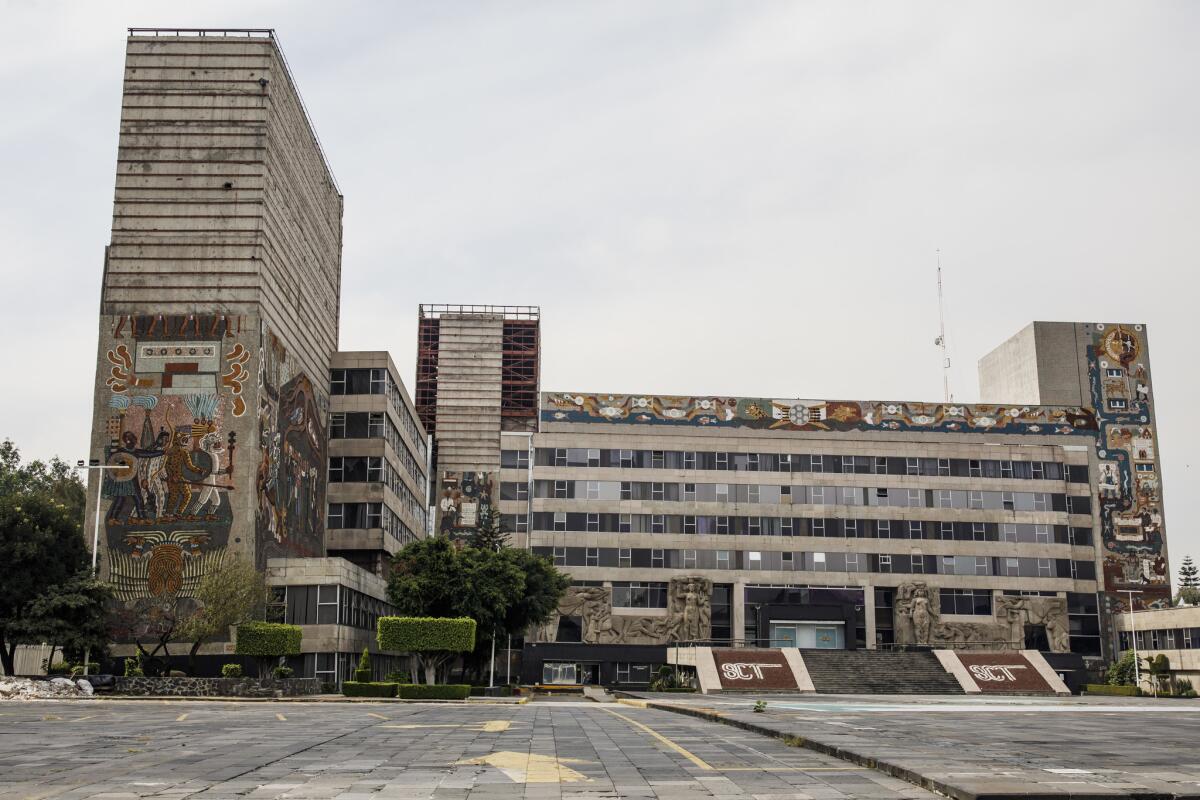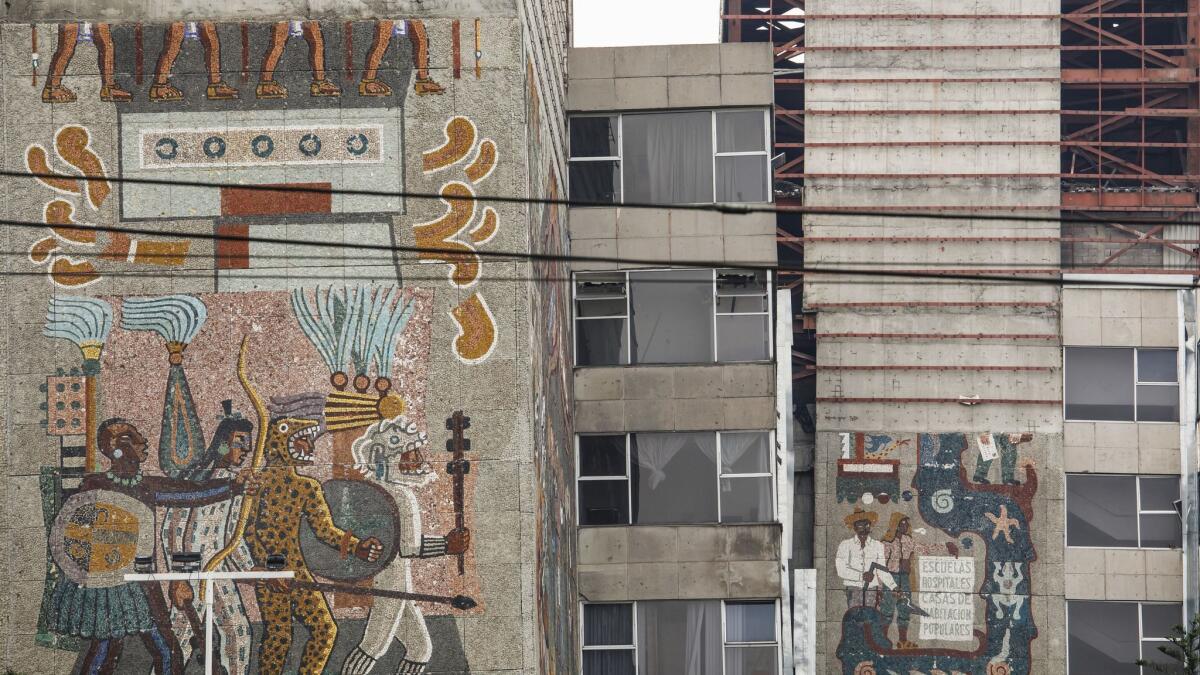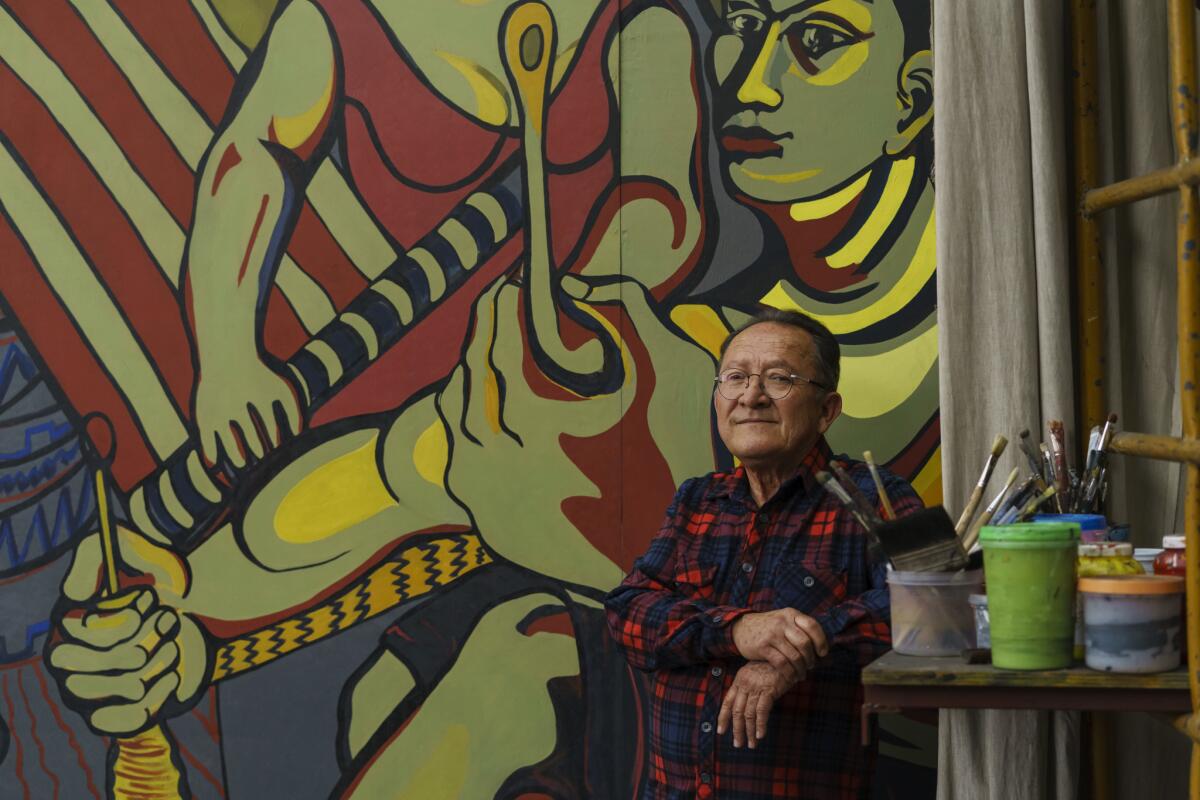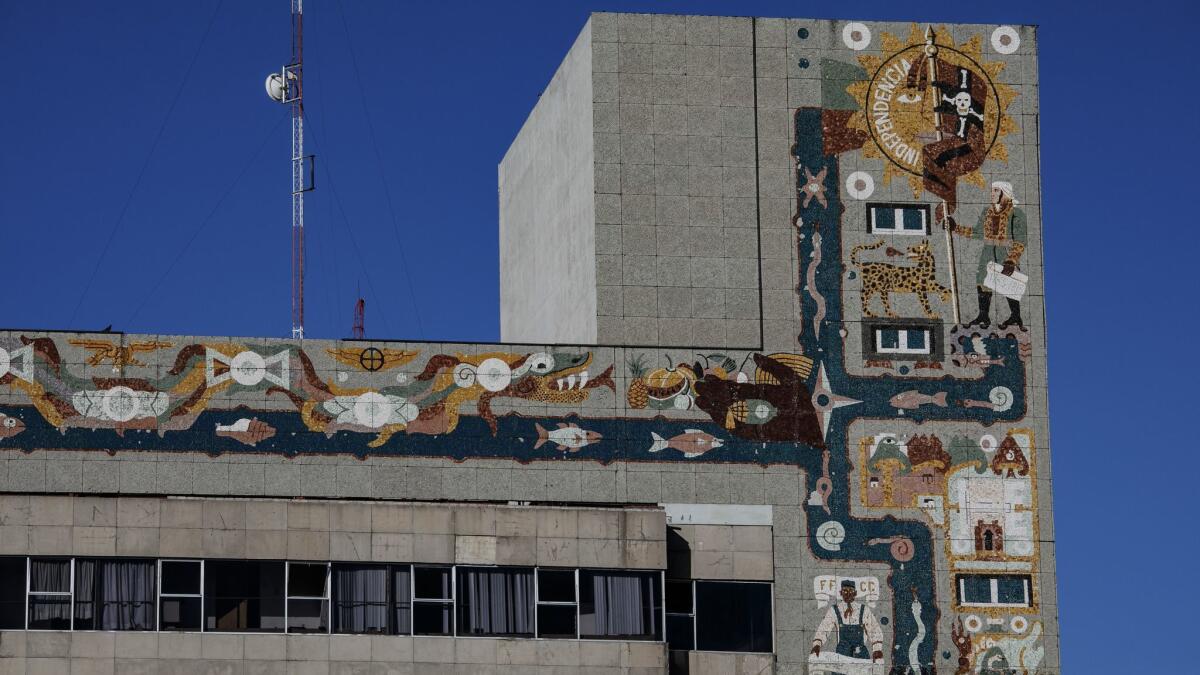A crumbling Mexico City complex harbors historic murals. Their fate? It’s complicated

- Share via
Reporting from Mexico City — When the late Mexican architect Carlos Lazo began planning work on the behemoth Mexico City headquarters for the country’s Ministry of Communications and Public Works in the early 1950s, he told the artists creating murals for its exterior to be guided by one principle: The Centro SCOP, as the complex is known in Spanish, should be “a work that lasts.”
“Let’s avoid the temporal and the anecdotal,” he added. “Look for symbols that are affirmative and eternal.”
Unfortunately, eternity for the Centro SCOP appears to have lasted just 63 years.
Once a grand arrangement of Modernist structures fronted by a plaza of Mesoamerican proportions and draped in murals by renowned artists such as Juan O’Gorman and José Chávez Morado, the complex, over the course of its life, has been devastated by a seismic one-two — not to mention the vagaries of national politics.
The first hit landed on Sept. 19, 1985, when an 8.0 magnitude quake tore through Mexico City, resulting in the total destruction of the top three floors of one of the Centro SCOP’s principal buildings — floors that were never replaced. The second blow came in 2017, 32 years to the date after the first one, when a 7.1 magnitude quake further damaged the buildings, leaving one of them leaning. In the wake of that disaster, the ministry — since renamed the Ministry of Communications and Transport (known as SCT in Spanish) — evacuated its more than 2,500 personnel due to safety concerns.
The Centro SCOP has lain empty ever since.

We have the responsibility to return something to the city that we have been taking away for 18 years: precisely, public space.
— Santiago Taboada, mayor of Mexico City’s Benito Juárez borough
After the 2017 quake, with no official pronouncements on the fate of the buildings, rumors began to swirl that the complex — along with its historic murals — might be demolished.
But Centro SCOP wasn’t just some random government building. It was a statement.
“It was a monument to construction in Mexico,” SCT Minister Javier Jiménez Espriú said at recent press conference. “It’s a culmination of a national project.”
The buildings harbor a uniquely Mexican form of mural making, in which colored stones from different regions are embedded in concrete panels (sturdy materials that can withstand all manner of urban elements). In addition, the scale at which they were deployed at Centro SCOP is unprecedented — which raises larger questions of how to preserve monumental architectural sites of this nature around the world.
Architect Mario Ballesteros, director of the experimental design space Archivo, says the buildings offer a case study in thinking about what preservation might mean if, for whatever reason, the buildings cannot remain intact.
“We know that, in 50 years, there are cities that will be under water — what does preservation mean there?” he says. “In Mexico, which is so [seismically] unstable, we are going to have to rely on more radical acts of preservation.”
Last February, Archivo staged an exhibition that featured work by artists in response to the uncertain future of the Centro SCOP complex. One hypothetical project floated the idea of disassembling the murals and installing the fragments at the new $13-billion international airport under construction in nearby Texcoco.
It was a wild idea that the government took seriously.
In a surprise move, Gerardo Ruiz Esparza, the previous head of the SCT, announced that the murals would be transferred to the new airport. By fall, some of the murals had been removed and placed in storage. The announced relocation and partial removal of the murals — undertaken without the public release of a structural report or a conservation analysis — generated an outcry from preservationists, who signed petitions and staged protests.
Mexican daily El Universal published an editorial decrying the plan and urged the government to make any reports on the state of the buildings public. The Aesthetic Research Institute at the National Autonomous University of Mexico (UNAM), which is focused on issues of preservation, also published an open letter criticizing the decision. Extracting the mural from the site would “alter the complex in a negative way,” the letter stated. “All of the regulatory and ethical documents that govern patrimony expressly advise against this.”

Carlos Lazo and SCOP, it was so important. It was a very exceptional moment for Mexican Modernism.
— Mario Ballesteros, architect
But things took a turn in the opposite direction in December, when Mexico’s new president, Andrés Manuel López Obrador, took office. López vowed to halt construction of the partially built airport on the grounds that the project has been a bonanza of corruption. That announcement left the mural plan up in the air ... until Feb. 13, when new SCT Minister Jiménez Espriú, a López appointee, announced at a press conference that Centro SCOP would be preserved and transformed into a cultural center
“Centro SCOP has been an icon of the city,” Jiménez Espriú said in his opening remarks. “It is a monument, not just a building.
“What we have clear from everybody is that this should be preserved. And that there is no way of rescuing this patrimony unless it is preserved right there. Make something somewhere in another place? No. Right there.”
Added Santiago Taboada, mayor of Mexico City’s Benito Juárez borough: “We have the responsibility to return something to the city that we have been taking away for 18 years: precisely, public space.”
None of this means that the Centro SCOP can breathe easy just yet.
For one, there is the mammoth scale of the complex. Centro SCOP is a 12-acre site whose principal architectural features are three large-scale Modernist office buildings laid out in an H. These are covered by 65,000 square feet of stone murals — you read the zeroes correctly. It is hard to convey in words what 65,000 square feet of murals looks like. It comes to 1.5 acres of mural, or about 30% bigger than a football field, end zones included.
In other words: rescuing the buildings, and the murals that hang on them, is going to be an epic undertaking.
An official report on the buildings’ condition has yet to be publicly issued, but Jiménez describes them as “unfit for habitation.”
“It’s a very complicated project,” he said during the press conference. “The first thing we need to do is remove the murals — who knows how much that will take or cost — then conserve them and store them. Then we’d have to examine the buildings. We’d probably have to demolish part of it and restructure other parts, then we’d have to re-do the foundation … I can’t tell you how long it would take or how much it would cost.”
When asked how the government might finance an architectural project of this scale, Jiménez suggested the possibility of a 0.5% optional surcharge on other infrastructural projects that could go toward rejuvenating SCOP.
“A small contribution,” he says, “we think it would have good reception.”
The SCT hasn’t articulated what the next steps on the project might be. Nor has it outlined any specific ways the buildings might be repurposed. When reached for comment via email, a spokeswoman for the ministry responded only with an audio file of the press conference.
That there is even a debate about saving Centro SCOP has a lot to do with the exhibition at Archivo.
In the immediate aftermath of the 2017 quake, the government had countless other problems to contend with, including dozens of fatalities and thousands of damaged buildings in a territory that spanned from Mexico City to Puebla. Often in natural disasters, the attention goes to colonial buildings. Ballesteros says it is important to draw attention to the country’s Modernist legacy too.
“Carlos Lazo and SCOP, it was so important,” he says, seated in the pleasant Modernist home that serves as Archivo’s gallery. “It was a very exceptional moment for Mexican Modernism.”
Lazo is perhaps best known for overseeing the design and construction of the Ciudad Universitaria, the iconic UNAM campus. That complex also features large-scale modernist buildings covered in murals — such as the Central Library, which was designed by Gustavo Saavedra and Juan Martínez de Velasco in collaboration with O’Gorman, who was both artist and architect. On its facade, the building bears a rock mural by O’Gorman that traces Mexican history through the ages. The building is now one of the visual signposts by which Mexico City is known.
After the completion of the Ciudad Universitaria, Lazo was named minister of public works and turned his attention to creating a headquarters for his ministry. On the site he inherited in Colonia Narvarte were the frames for what had once been intended to be a public hospital. Lazo, with the assistance of two other architects — Augusto Pérez Palacio and Raúl Castro — helped turn these into Centro SCOP.

Like the Ciudad Universaritaria, rock murals were added to break up the monumental scale of the buildings. The designs told the history of Mexico’s great public works, featuring art by high-profile artists such as O’Gorman and Chávez Morado, as well as a slew of other important midcentury figures, including Rosendo Soto, José Gordillo, Guillermo Monroy, Arturo Estrada, Luis Garcia Robledo and Jorge Best.
When Archivo opened its exhibition last year, it intended to highlight the legacy of the complex at a moment in which its fate was in question.
“What we didn’t want was for four months to go by and no one has anything to say about SCOP,” says Ballestero.
For the show, artist Pedro Reyes made a sculpture of a raised fist that employed the Mexican rock mural technique. The collective Tercerunquinto gathered floor tiles from the Centro SCOP that had been displaced by the quake and used them to create an abstract geometric installation. Also on view were various design schematics by architect Fernando Romero, a founder of Archivo, who also happens to be the architect for that $13-billion airport. These showed fragments of the SCOP murals installed as decorative elements around the terminals.
“When we did the show, we knew it was sensational,” says Ballesteros. “It was a provocation. But it seemed feasible. The day after the earthquake, the reports were that the buildings would be demolished.”
The proposal, naturally, generated controversy — not to mention international headlines. And it grew even more heated after Ruiz Esparza announced that the murals would indeed be relocated to the airport. The announcement, says Ballesteros, caught everyone by surprise. “Everyone was still waiting for the structural report,” he says. “There had been no discussion about it.”
The announcement ignited a wave of opposition.
MORE: A Mexican town watches its ‘Roma’ star shine. Another treasure’s fate is less clear »

“Those murals belong to the people,” says Ariosto Otero, who helped establish En Defensa del Patrimonio del Centro SCOP, a preservation group consisting of artists, intellectuals and preservationists. “That idea to chop them into pieces — it’s dismembering, to use anatomical terms.”
Otero, who is a muralist himself, says that to divorce the murals from the architecture is to strip them of their context.
“The murals tell the story of communications back to the ancient Mexicans,” he says, seated in a studio cluttered with concept drawings for various commissions. “The idea here was to place them as decorative pieces in the airport.”
“Decorative,” he says again with a tone of disgust.
Last fall, the SCT removed numerous mural panels from a building in the complex that had begun to lean in wake of the earthquake. At the time, the country’s Fine Arts Institute (INBA, in Spanish) issued a press release stating that it had approved the removal, but no structural reports were made public, nor did the government hold any public meetings on the Centro SCOP.
This left many to assume that the fragments were being hauled off to the new airport. In an interview with the Mexican daily Excelsior, Leopoldo Best, the son of one of the muralists, likened the removals to an act of “cultural pillage.”
The inauguration of a new presidential administration in December, and along with that, new leadership at the SCT, has given the Centro SCOP a stay of execution.
But now the question remains: How do you preserve a gargantuan building complex from the 1950s that is covered in 1.5 acres of heavy rock murals — all of which may be structurally unstable? Determining those answers will likely require a mountain of political will and an equivalent mountain of resources.
In the meantime, Centro SCOP sits barricaded, half stripped, a monument not to a nation under construction but instead one that is perhaps beginning to fray.

Sign up for our weekly Essential Arts & Culture newsletter »
carolina.miranda@latimes.com | Twitter: @cmonstah
More to Read
The biggest entertainment stories
Get our big stories about Hollywood, film, television, music, arts, culture and more right in your inbox as soon as they publish.
You may occasionally receive promotional content from the Los Angeles Times.











